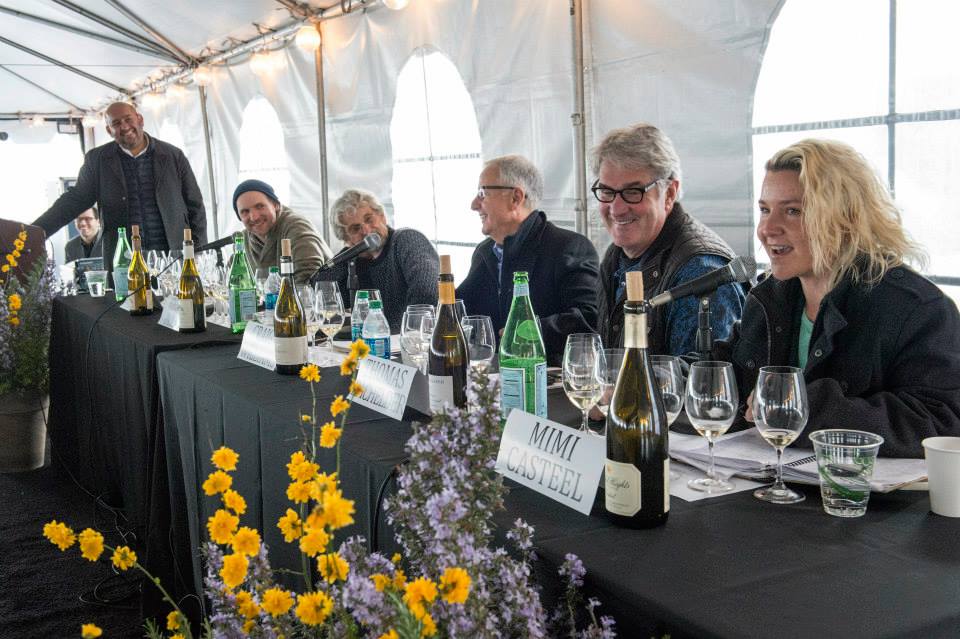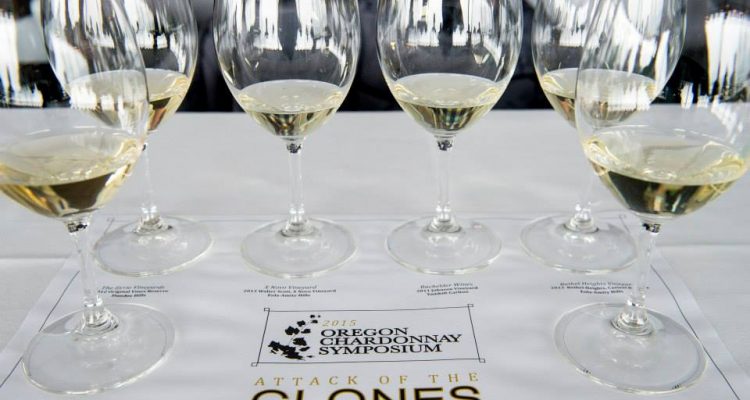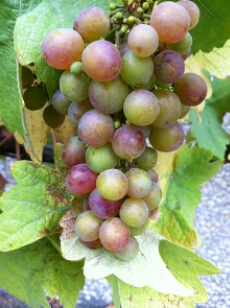Staff writer and Pacific Northwesterner Mary Cressler explores the controversial nature of discussing Oregon’s clones of Chardonnay in this piece from March.
Oregon’s controversial history with chardonnay clones culminated into one question earlier this month: do clones matter when it comes to chardonnay? We were there to find out at the fourth annual Oregon Chardonnay Symposium held at Stoller Family Estate in the Willamette Valley. Those who attended the technical panel titled “Attack of the Clones” likely left the seminar with the conclusion that perhaps they don’t matter at all. In fact you may have even found yourself on team “end the clones.”
Before I go on, you may be wondering what the heck is a clone anyway and why was there an event attended by several hundred people to discuss chardonnay clones?

A clone is a cutting from a mother vine, replanted to create a genetically identical version of its mother. Or, as Jason Lett, second-generation winemaker for The Eyrie Vineyards simply explained, “Go into vineyard, cut a piece of stick, put the stick halfway in the ground. The buds in the ground grow roots; the ones above the ground grow leaves. Boom, you have a plant that is genetically identical to the plant that you got the stick from. And that is a clone.”
These clones are chosen (or eliminated) because they exhibit key characteristics, such as berry or cluster size, specific aromas, flavors, resistance to disease, etc. And Oregon has an important, and yet controversial, history of clones as they pertain to Chardonnay.
Lett passionately began the discussion when he welcomed attendees to the end of the clone era, encouraging us to all “stop talking about [clones].”
Rajat Parr, who moderated the five person panel, admitted to never putting much thought into clones until he started making wine, and echoed Lett’s sentiment when he said, “We should all have t-shirts that say ‘end of clones.’”
So, do clones even matter?
If you were to leave that seminar, based on these opinions alone, you’d be confused to why the organizers put so much effort into an event called “Attack of the Clones” if the whole point to be made was clones don’t matter and we don’t need to talk about them. At least that’s how I felt. Luckily I ran into some winemakers brave enough to explain how this rift came about and who defended the importance of the clone.
But first, let’s backtrack about fifty years.
Oregon’s history of chardonnay is traced back to 1964 when David Lett of The Eyrie Vineyards brought back chardonnay cuttings, referred to as “Draper Selection,” coming from a selection of clones from Draper Ranch in Saint Helena, California. These selections can be traced back to their origins in France, brought to California in the late 1800’s and early 1900’s.
During the 60’s and 70’s early Oregon pioneers began to plant these “Draper Selection,” and also Wente clones brought up from California, from Wente Vineyard in Livermore Valley. This original Wente clone is also traced to France, both Burgundy in 1882 and Southern France in 1912.
The term “Wente” can be a confusing reference. The original Wente selections brought to California from France were prone to millerandage, also referred to as “hens and chicks,” which produce clusters of inconsistent berry size, and also very small yields caused by viruses. So in 1964 UC Davis created a program that heat-treated a selection of these cuttings, which eliminated the “hens and chicks” tendency and created much larger yields (5+ tons per acre vs. ½ ton per acre). They immediately took off in popularity. This heat-treated clone is called the UCD 108 selection. So we now have the Old Wente, and the heat-treated 108.
Up in Oregon, they planted both. Those who planted the 108 noticed it was performing less than ideally, producing very high yields and ripening late, at least two weeks later then pinot noir. This struck winemakers as odd and frustrating since the two Burgundian varieties should be performing to equally high standards in this cool climate region. Not only were the grapes ripening much later than pinot noir, but also the resulting wines were rather uninspiring. Most, but certainly not all, winemakers had a hard time producing the quality Oregon is known for today.
Then, in 1974, David Adelsheim traveled to Burgundy in search of both pinot noir and chardonnay clones to experiment with back home. What he discovered was that the chardonnay there was ripening at the same time as pinot noir. He was determined to bring these back to Oregon. Throughout the next few years he worked with Oregon State University to set up a quarantine and disease evaluation program in order to bring these clones from Burgundy to Oregon. These clones are collectively referred to as the Dijon clones (though there are more specific titles associated with each specific clone, along with qualities of each type).
These Dijon clones changed the scene for Oregon chardonnay, in a dramatic way. And, in order to prove to the world that Oregon’s chardonnays could stand up to those produced in California and across the pond, they needed a marketing strategy. An organization called ORCA, the ORegon Chardonnay Alliance, was even formed to discuss the “rebirth of Oregon chardonnay,” but only those who had switched to the Dijon clones could be accepted into the organization. This then became the Dijon vs. Heritage story (Heritage generally referring to those original clones that were never heat-treated through UC Davis). Or, what seemed more like the Dijon vs. Heritage war.
The story Oregon began to tell was that Oregon was making lackluster chardonnay until the Dijon clones came in to save the day. It was a necessary story at the time to bump up Oregon as a region.

That story “fixed a problem in the region. And that’s what people gathered around 10-15 years ago,” Mimi Casteel, winegrower at Bethel Heights Vineyard, explained. I followed up with Casteel and a few other winemakers after the seminar to clear the confusion I left with.
She continued, “But that story played itself out, and alienated a lot of us, including myself, who still had original selections in the ground and have been making chardonnay that we felt very good about during this entire time, with those [original] selections in the ground.”
There was a need to put a spin on the negative discussions around chardonnay at the time, and it’s understandable that this message evolved. “But it’s not a good message anymore,” Casteel believes.
Is there a quality difference between the different clones or selections?
Several winemakers who never switched to the Dijon clones are making excellent examples of chardonnay, Lett’s The Eyrie Vineyards wines included. Does that mean the Dijon story isn’t still important?
Going back to the seminar, it seems as if this rift still clearly exists. And you’d think there were two clear sides, Team Modern (or Dijon) and Team Purist (or Heritage, and original cuttings from California).
So, are clones even important and should we even be discussing them?
Dave Paige, winemaker at Adelsheim, firmly believes so. And he believes both sides are important to share. “The notion that somehow people are choosing to be purist or heritage vs. modern and sterile and uninteresting is a false dichotomy that is being created. There are a lot of us doing both.”
To disregard the importance that the Dijon clones brought to the valley is, what Paige calls, “anti-learning.”
“The truth is in the nuance,” Paige continues. “The fact that there was some great [chardonnays] back then does not mean that we didn’t need to change things.” There were real problems with several of the wines back then, and the wines have improved dramatically since, and continue to improve every year.
While it’s clear that many on the panel want the discussion of clones to end, Paige believes this is an important conversation to continue. “We should care about what we plant. Just like where we plant it, and if we should do a cover crop… we should care about all of that. And, we should care about clones!”
Depending on the vineyard site, a clone is a vital element to consider. If you have a hot exposed site, with quick drainage, you might want more of a Heritage clone, rather than a Dijon, Casteel explained to me. You must “look for what’s right for your site,” she continued.
Paige also echoed the importance of site over clone, but that clone is still a huge consideration. “What I consider a mediocre performing clone from my favorite site is better than my favorite clone from a mediocre site. Site does trump clone,” but clones shouldn’t be dismissed.
“I’m not putting the Dijon clones on a pedestal. There are some great options. And they should not be ignored because some other [clones] came first,” Paige explained.
At one point during the seminar Thomas Bachelder from Bachelder Wines expressed concern that we focus too much on clones, and that other regions, like Burgundy and elsewhere, don’t put as much focus on them. “Burgundy is all about field blends,” and not about specific clones. It was implied that in Burgundy they don’t even know, nor care about, the specific clones within their vineyard.
In my follow up conversation with Paige he called B.S. on that. “The idea that Burgundians don’t do this is crazy! They do [focus on clone selection].” He continued, “Why are we allowing the entire room to think that there’s a purist way to do things that doesn’t involve clones, and a modern-lesser way that does involve clones? Most wine regions in the world don’t do it one way or another, but instead some hybrid way of the two.”
The conversation needs to shift from which clone or selection is better for Oregon, to the elements and factors that collectively add up to create quality chardonnay.
Clones are a part of this conversation. But they are only one part in the whole picture. “It may not be the one thing you point to define your region,” Casteel shared. But, “you also don’t want to walk around saying you don’t consider it at all.”
At the end of the day, the message, which got jumbled in the mix of controversy over the history, and passionate winemakers, was really about the desire say “we’re not going to define Oregon chardonnay alone by this clone debate anymore.”
So, perhaps, instead of a t-shirt that says “end of clones,” it should say, “end the clone wars.”
All photos (except grape cluster) courtesy of Andrea Johnson Photography.


